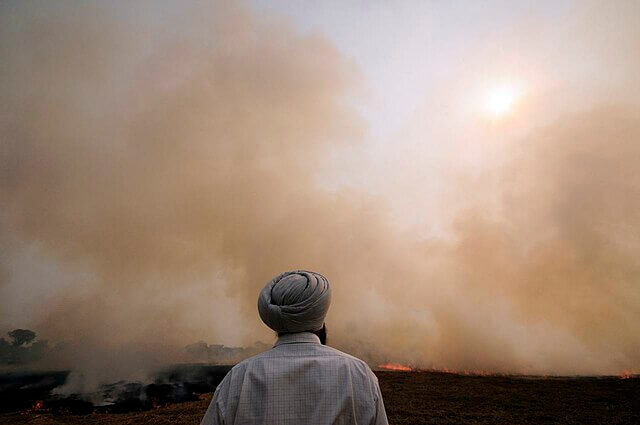
The first-of-its-kind study in India reveals a concerning link between exposure to air pollution and an increased risk of type 2 diabetes.
Conducted in Delhi and Chennai, the research demonstrates that inhaling air with elevated levels of PM2.5 particles is associated with higher blood sugar levels and a heightened incidence of type 2 diabetes. PM2.5 particles, being 30 times thinner than a human hair strand, can enter the bloodstream when inhaled, leading to various respiratory and cardiovascular diseases.
The study, part of an ongoing research initiative into chronic diseases in India since 2010, sheds light on the impact of ambient PM2.5 exposure on diabetes in a country notorious for air pollution. The annual PM2.5 levels in Delhi ranged from 82-100μg/m3, while in Chennai, they were 30-40μg/m3—both significantly exceeding WHO limits of 5μg/m3 and India’s national air quality standards of 40μg/m3.
India faces a high burden of non-communicable diseases, including diabetes, hypertension, and heart disease. A Lancet study indicates that 11.4% of the population, equivalent to 101 million people, are living with diabetes, with an additional 136 million pre-diabetic individuals.
This prevalence surpasses previous estimations and reveals higher diabetes rates in urban areas than rural regions. In comparison, the European Union had an average diabetes prevalence of 6.2% in 2019, and the UK reported 8.6% in 2016.
The BMJ study tracked a cohort of 12,000 individuals in Delhi and Chennai from 2010 to 2017, measuring their blood sugar levels periodically. Using satellite data and air pollution exposure models, the researchers correlated air pollution in participants’ localities with blood sugar levels.
The findings indicate that one month of PM2.5 exposure led to increased blood sugar levels, and prolonged exposure of one year or more elevated the risk of diabetes. For every 10μg/m3 increase in annual average PM2.5 levels, the diabetes risk increased by 22%.
“Given the pathophysiology of Indians – low BMI with a high proportion of fat – we are more prone to diabetes than the western population,” said Siddhartha Mandal, lead investigator of the study and a researcher at Centre for Chronic Disease Control, Delhi.
The study underscores the compounding effect of air pollution, coupled with lifestyle changes, contributing to the rising burden of diabetes. Another study on the same cohort in Delhi found that annual exposure to PM2.5 increased blood pressure levels and the likelihood of developing hypertension.
Both studies collectively emphasise that elevated PM2.5 levels in Indian cities contribute to diabetes and hypertension, raising the risk of atherosclerosis, heart attacks, and heart failures.
“Until now, we had assumed that diet, obesity and physical exercise were some of the factors explaining why urban Indians had higher prevalence of diabetes than rural Indians,” said Dr V Mohan, chairman of the Madras Diabetes Research Foundation and one of the authors of the paper. “This study is an eye-opener because now we have found a new cause for diabetes that is pollution.”
PM2.5 particles contain substances like sulphates, nitrates, heavy metals, and black carbon, which can damage blood vessels, stiffen arteries, deposit in fat cells causing inflammation, and directly affect the heart muscle.
Acting as an endocrine disruptor, PM2.5 hampers insulin production and function, contributing to diabetes. The study also suggests a potential link between air pollution and other endocrine-related conditions such as hypothyroidism, polycystic ovarian syndrome (PCOS), and gestational diabetes.
Future research will explore pollution’s impact on cholesterol and vitamin D levels, as well as its influence on various life cycle stages, including birth weight, pregnant women’s health, insulin resistance in adolescents, and the risk of Parkinson’s and Alzheimer’s disease.
Despite alarming findings, the study offers hope that reducing pollution can alleviate the burden of diabetes and other non-communicable diseases. Certain public policy initiatives in India, such as restricting older diesel vehicles, controlling construction activities, constructing bypass highways, and prohibiting crop burning, have shown a 22% reduction in PM2.5 levels between 2016 and 2021, indicating the potential effectiveness of pollution control measures.
“This is a modest but welcome reduction. Similar measures adapted to local conditions are urgently needed across the country,” said Prabhakaran.
——————————————————————————
At Natural World Fund, we are passionate about stopping the decline in our wildlife.
The decline in our wildlife is shocking and frightening. Without much more support, many of the animals we know and love will continue in their decline towards extinction.
When you help to restore a patch of degraded land through rewilding to forests, meadows, or wetlands, you have a massive impact on the biodiversity at a local level. You give animals a home and food that they otherwise would not have had, and it has a positive snowball effect on the food chain.
We are convinced that this is much better for the UK than growing lots of fast-growing coniferous trees, solely to remove carbon, that don’t actually help our animals to thrive.
This is why we stand for restoring nature in the UK through responsible rewilding. For us, it is the right thing to do. Let’s do what’s right for nature!
Donate today at https://naturalworldfund.com/ and join in the solution!

